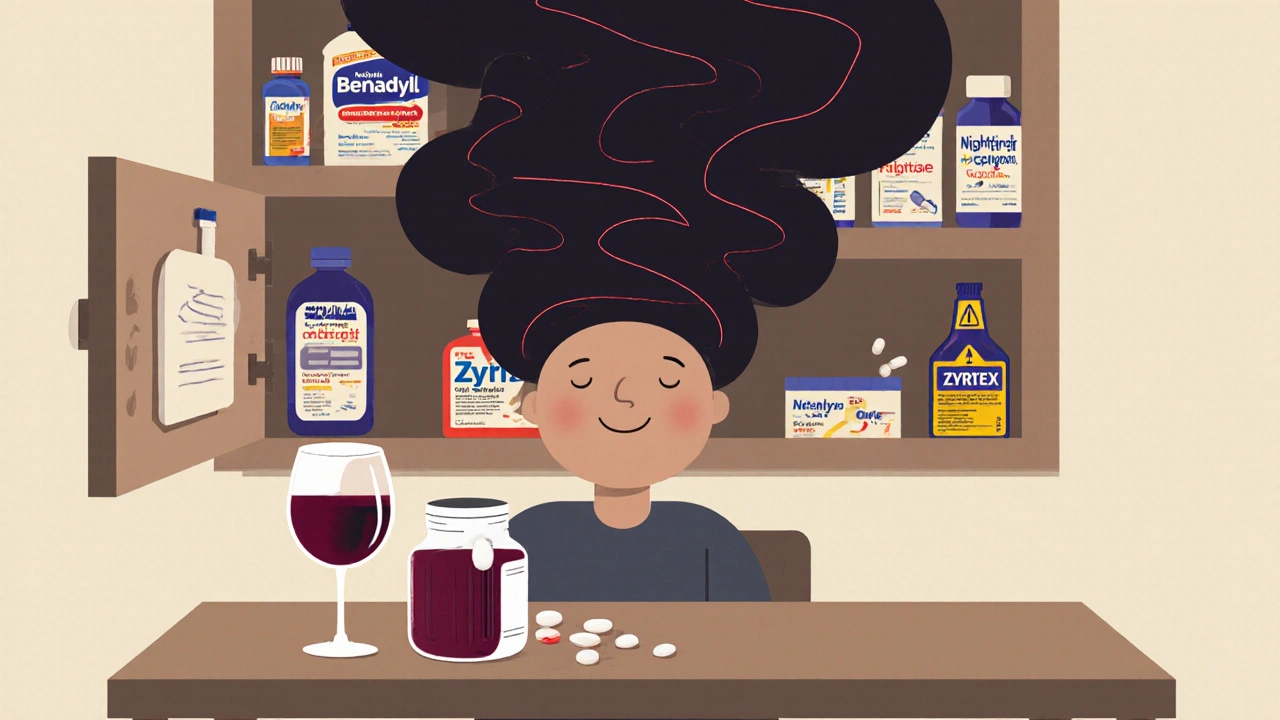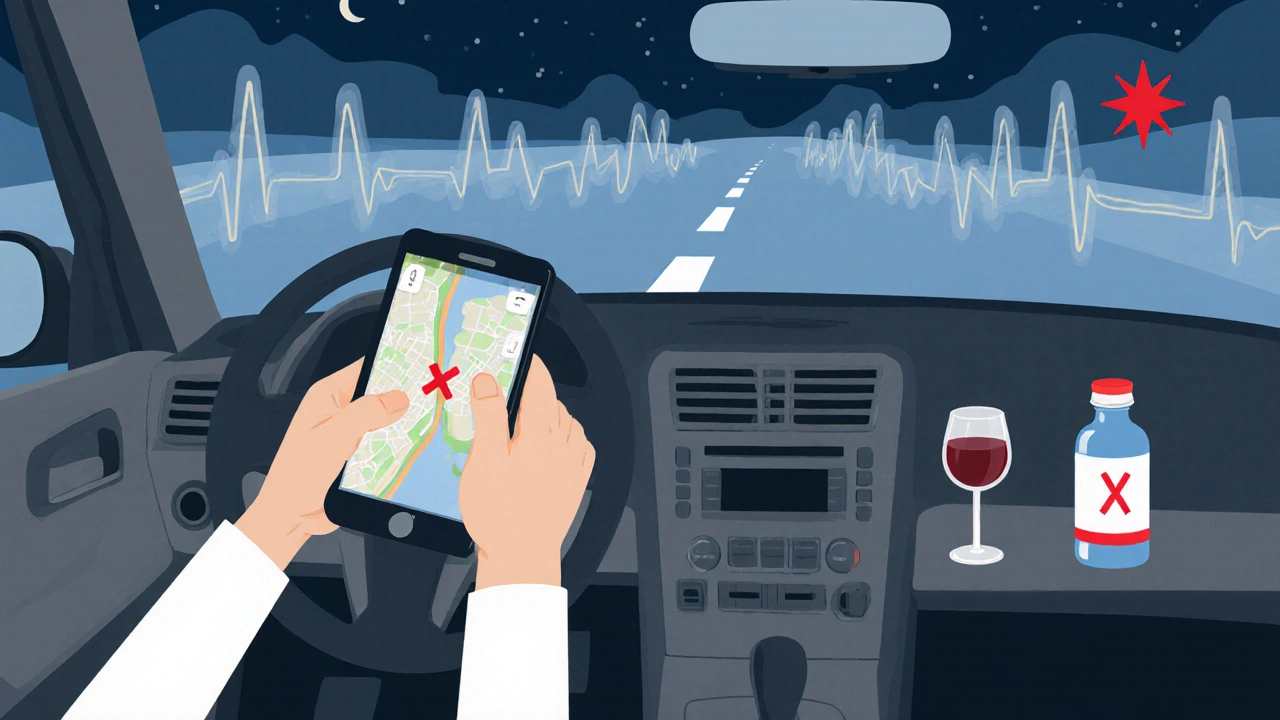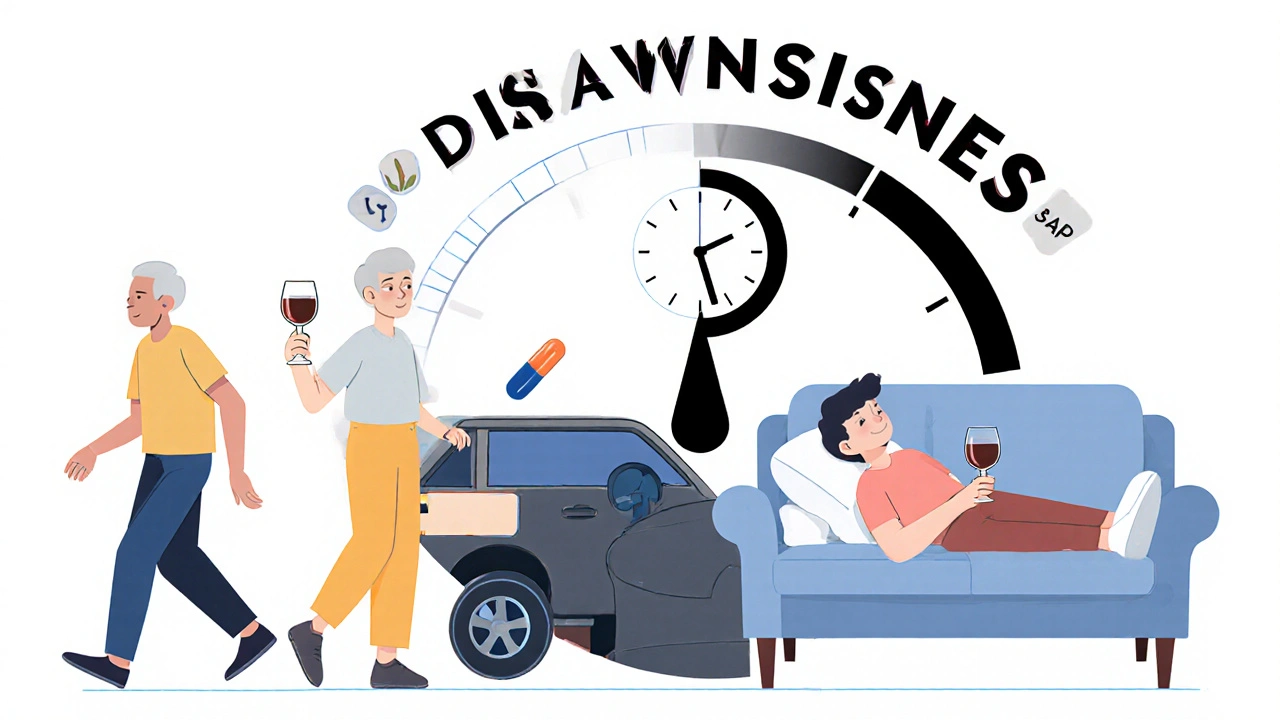Antihistamines and Alcohol: Why Mixing Them Increases Drowsiness Dangerously
 Nov, 23 2025
Nov, 23 2025
Antihistamine-Alcohol Risk Calculator
How Safe Is Your Combination?
Enter your antihistamine type and alcohol consumption to see your risk level. Remember: alcohol can turn any antihistamine into a stronger sedative.
Risk Assessment
Estimated Drowsiness Risk
Reaction Time Impairment
Safety Recommendation:
Drinking a beer after taking your allergy pill might seem harmless-until you can’t stay awake behind the wheel or wake up disoriented the next morning. The truth is, mixing antihistamines and alcohol isn’t just a bad idea-it’s a medical risk many people don’t realize they’re taking. Even if you’re using a "non-drowsy" allergy medicine, alcohol can turn a mild side effect into something dangerous.
Why Drowsiness Gets Worse When You Mix Them
Both alcohol and antihistamines slow down your central nervous system. Alcohol does it by boosting GABA, a brain chemical that calms activity, and blocking NMDA receptors that keep you alert. First-generation antihistamines like diphenhydramine (Benadryl) work by blocking histamine in the brain, which normally keeps you awake. When you combine them, their effects don’t just add up-they multiply. Clinical studies show this combo can reduce reaction time by 47% more than alcohol alone. That’s not just feeling tired. That’s impaired driving, delayed reflexes, and poor decision-making.Not All Antihistamines Are the Same
There are two main types: first-generation and second-generation. First-generation ones-like diphenhydramine (Benadryl), chlorpheniramine, and doxylamine-are designed to cross into the brain. That’s why they make you sleepy. About half of people who take them report drowsiness. Add alcohol, and that number jumps to 60% or higher. Even one drink with two Benadryl tablets can leave you as impaired as someone with a blood alcohol level of 0.12%, which is above the legal driving limit in every U.S. state. Second-generation antihistamines like loratadine (Claritin), cetirizine (Zyrtec), and fexofenadine (Allegra) were made to avoid the brain. Alone, they cause drowsiness in only 6-20% of users. But alcohol changes that. With one drink, Claritin’s drowsiness rate jumps to 30-35%. Zyrtec goes from 15-20% to 40-45%. The liver can’t process both at once. Alcohol blocks the enzymes that break down antihistamines, so they stick around longer. That means more drowsiness, more confusion, and more risk.What’s in Your Medicine Cabinet?
Diphenhydramine isn’t just in allergy pills. It’s hidden in 72 over-the-counter products: sleep aids, cold medicines, motion sickness tablets, and even some pain relievers. You might think you’re just taking a nighttime cold remedy, but if it says "diphenhydramine" on the label, you’re taking the same drug as Benadryl. And if you had a glass of wine earlier? You’ve just created a dangerous mix. The FDA requires prescription antihistamines to carry strong warnings about alcohol, but OTC products only have small print that says "may cause drowsiness." They don’t mention alcohol at all.
Who’s at Highest Risk?
Older adults are the most vulnerable. People over 65 metabolize both alcohol and antihistamines slower. The FDA says they experience 2.3 times more CNS depression than younger adults. That means a single drink with an antihistamine can cause extreme dizziness, confusion, or falls. A 2022 study found older users had a 75% higher risk of hip fractures after combining the two. Younger people aren’t safe either. Reddit users reported 32% of those who mixed antihistamines with alcohol had fallen asleep while driving. In drug reviews, 28% said they "passed out unexpectedly," and 19% couldn’t wake up the next morning.Real Stories, Real Consequences
A 58-year-old woman in Ohio took Zyrtec for her seasonal allergies and had one glass of wine with dinner. She woke up in the emergency room with low breathing and confusion. She didn’t remember how she got there. A 32-year-old man in Texas took Benadryl for a bug bite, then drank two beers at a barbecue. He fell asleep at the wheel, hit a tree, and broke his collarbone. These aren’t rare cases. Emergency visits linked to antihistamine-alcohol interactions have gone up 37% since 2018. Most of them involve first-generation antihistamines, and 42% of cases required hospitalization for breathing problems.
What Should You Do Instead?
If you drink alcohol regularly, switch to alcohol-safe allergy treatments. Nasal sprays like Flonase (fluticasone) or Nasacort (triamcinolone) work locally in your nose-no brain involvement. Leukotriene blockers like Singulair (montelukast) also don’t interact with alcohol. The catch? They take 3-7 days to work fully. So if you need fast relief, avoid alcohol entirely. If you must take a first-generation antihistamine, wait at least 12-16 hours before drinking. For second-generation ones, wait 8-12 hours. But even then, your body’s metabolism varies. Factors like age, weight, liver health, and genetics all affect how fast you process these drugs. If you’ve ever felt unusually sleepy after a drink and an allergy pill, don’t assume it’s just you. It’s the science.When to Seek Help
If you or someone else takes antihistamines and alcohol and then experiences: deep drowsiness, slow or shallow breathing, confusion, inability to wake up, or loss of coordination-call emergency services immediately. These aren’t signs of just being "too tired." They’re signs of CNS depression that can turn fatal.Bottom Line
There’s no safe amount of alcohol when you’re taking most antihistamines. Even "non-drowsy" options aren’t risk-free. The myth that second-generation antihistamines are safe with alcohol is dangerous. The data shows clearly: alcohol turns any antihistamine into a stronger sedative. If you’re managing allergies and enjoy an occasional drink, talk to your doctor about alternatives that won’t put you to sleep-or worse. Your brain, your reflexes, and your safety matter more than convenience.Can I have one drink with Zyrtec?
Even though Zyrtec (cetirizine) is labeled "non-drowsy," it still causes drowsiness in 15-20% of people on its own. With just one drink, that risk jumps to 40-45%. You might feel fine, but your reaction time and coordination are still impaired. It’s not worth the risk, especially if you’re driving, operating machinery, or need to be alert.
Is Benadryl more dangerous with alcohol than other antihistamines?
Yes. Benadryl (diphenhydramine) is a first-generation antihistamine designed to enter the brain. It causes drowsiness in about half of users alone. With alcohol, drowsiness increases to 60% or higher, and impairment can match a blood alcohol level of 0.12-0.15%-well above the legal driving limit. It’s the most dangerous common antihistamine to mix with alcohol.
Can I take Claritin and drink alcohol if I feel fine?
Feeling fine doesn’t mean you’re safe. Alcohol slows how your body clears Claritin (loratadine), making the drug stay in your system longer. Studies show drowsiness increases from 10-15% to 30-35% when combined with alcohol-even if you don’t notice it. Your reflexes are still slower, and you’re at higher risk for accidents.
What if I accidentally mixed alcohol and antihistamines?
If you feel excessively drowsy, confused, or have trouble breathing, seek medical help right away. If you’re just feeling a bit sleepy, don’t drive, operate machinery, or make important decisions. Drink water, rest, and avoid more alcohol. Monitor yourself for the next few hours. Symptoms can worsen as the alcohol and antihistamine continue to interact in your system.
Are there allergy medicines that are safe with alcohol?
Yes. Nasal corticosteroids like Flonase and Nasacort, and leukotriene inhibitors like Singulair, have no known interactions with alcohol. They don’t cause drowsiness and don’t affect the central nervous system. The downside? They take 3-7 days to reach full effect, so they’re not ideal for sudden flare-ups. But for daily allergy management, they’re a much safer choice if you drink.
Why do some people say they’re fine mixing them?
People’s bodies react differently. Some metabolize alcohol and antihistamines faster, so they feel less affected. But that doesn’t mean their body isn’t impaired. Studies show reaction times and coordination are still reduced-even if the person doesn’t feel sleepy. The risk of accidents doesn’t disappear just because you feel okay.
How long should I wait after taking antihistamines before drinking alcohol?
For first-generation antihistamines like Benadryl, wait 12-16 hours. For second-generation ones like Claritin or Zyrtec, wait 8-12 hours. But these are general guidelines. If you’re older, have liver issues, or take other medications, your body may need even longer. When in doubt, skip the alcohol.
Jacob McConaghy
November 24, 2025 AT 08:43Man, I thought I was fine mixing Zyrtec and a beer until I nearly crashed into a mailbox last summer. Didn't even feel drunk, just... out of it. Now I just use Flonase and call it a day. Worth the wait.
Also, why do drug companies not put big-ass warnings on OTC stuff? Like, come on.
Natashia Luu
November 25, 2025 AT 03:24This is precisely why modern medicine has become a dangerous farce. The pharmaceutical industry profits from ignorance, and the FDA is complicit. You think they care about your safety? They care about liability waivers and marketing margins. This is systemic negligence dressed up as public health advice.
akhilesh jha
November 26, 2025 AT 04:52Interesting. In India, many people mix antihistamines with alcohol without thinking. My uncle took Benadryl for a rash and had three beers - slept for 14 hours. Woke up confused but fine. Maybe it’s genetics? Or just luck?
Jeff Hicken
November 27, 2025 AT 21:54so like… benadryl + beer = drunker than drunk? lol i thought i was just tired. also why is this even a thing? why do they even make these pills if they’re gonna kill you with a sip of wine??
Vineeta Puri
November 28, 2025 AT 12:53It is imperative that individuals exercise caution when combining pharmacological agents with psychoactive substances. The pharmacokinetic interaction between antihistamines and ethanol is well-documented in peer-reviewed literature. One should prioritize health over social convenience.
Victoria Stanley
November 29, 2025 AT 13:07For anyone reading this - if you’re on antihistamines and drink, you’re not being "strong" or "fine." You’re just not noticing how slow your brain is. I used to do it all the time until I forgot to pick up my kid from school because I passed out on the couch. Never again.
Flonase saved my life. Seriously.
Also, if you're over 60? Just say no.
steven patiño palacio
December 1, 2025 AT 05:18There’s a critical gap in public education here. The term "non-drowsy" is misleading and irresponsible. It implies safety where none exists. Second-generation antihistamines reduce drowsiness, not eliminate it - especially when combined with alcohol. Regulatory bodies should require clearer labeling and consumer advisories. This isn’t just medical advice - it’s public safety.
stephanie Hill
December 1, 2025 AT 10:36They don’t want you to know this. The FDA, Big Pharma, the alcohol industry - they’re all in cahoots. Why? Because if people stopped mixing Zyrtec with wine, sales would drop. They profit from your drowsy, confused, crash-prone self. And the worst part? They’ve known this for decades. That tiny "may cause drowsiness"? That’s a death sentence wrapped in fine print.
Wake up. 🕵️♀️
Akash Chopda
December 2, 2025 AT 10:01Sam Jepsen
December 3, 2025 AT 17:37Bro I just found out I’ve been doing this for years and didn’t even know it. Took Claritin for pollen and had a beer after work - thought I was just tired. Now I’m switching to Nasacort. Also, if you’re using any nighttime cold med? Check the label. Diphenhydramine is everywhere. I almost died last winter. Seriously. Don’t be me.
Yvonne Franklin
December 5, 2025 AT 00:06Not worth it
Nikki C
December 5, 2025 AT 11:45It’s wild how we normalize this. We treat our bodies like machines you can overclock with caffeine and ignore with alcohol - then wonder why we crash.
Maybe we’re not broken. Maybe we’re just drowning in convenience culture.
My grandma took Benadryl with whiskey every night. She lived to 92. But she also fell three times last year. Coincidence? Or biology catching up?
We need to stop romanticizing "I’m fine" as strength. Sometimes it’s just denial with a side of denial.
And yeah - I still drink. But now I wait. Or I switch. Because my brain deserves better than a chemical tug-of-war.
Alex Dubrovin
December 5, 2025 AT 15:39just stopped drinking after my allergy meds
no more "one beer"
no more "i feel fine"
just… peace
and better sleep
and no more waking up in weird places
thanks for the wake up call
literally
Andy Louis-Charles
December 6, 2025 AT 15:31Just switched to Singulair last month. No drowsiness. No alcohol worries. Took 5 days to kick in, but now I can have a glass of wine without feeling like a zombie. 🙌 Also, if you’re using NyQuil or Excedrin PM? Yeah, that’s diphenhydramine too. Check your labels. Seriously.